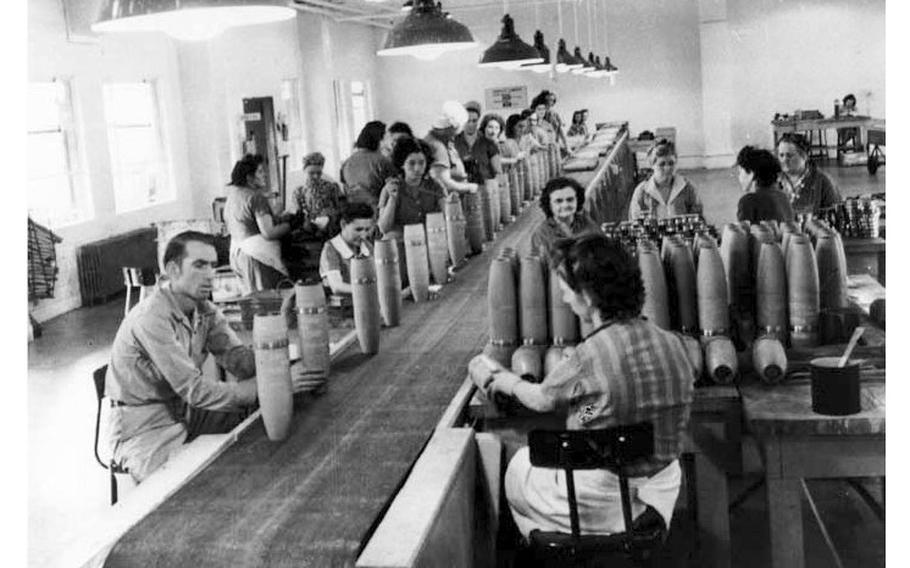
A World War II era image shows munitions production at Redstone Arsenal in Alabama in the 1940s. (U.S. Army)
HUNTSVILLE, Ala. (Tribune News Service) — Huntsville’s Redstone Arsenal is getting new attention for an ongoing $1 billion cleanup of old and unexploded chemical and conventional munitions from burial sites on the base.
The online military website Army.mil featured the chemical munitions cleanup in February focusing on soldiers who get experience with chemical agents through the operation. An unexploded ordnance supervisor interviewed for the story estimated the work will continue through 2025.
Known today as home to major U.S. military commands and a top NASA center, the Huntsville “arsenal” was literally that – a large Army munitions factory – during and for a period after World War II. American troops also brought home unused munitions and captured enemy munitions that ended up at Redstone for study and disposal after the war.
So far, 3,500 “munitions and explosives of concern” have been removed from ground, said one official involved in the Redstone cleanup. They are taken from the recovery sites overnight or early in the morning by different routes to “magazines” – buildings covered with dirt – to await disposal.
“This ordnance was either buried intact, burned or detonated during authorized disposal in the 1940s - 1960s,” project supervisor Steven Tewhill told Army.mil. “Most of the munition residue encountered shows a complete disposal, although occasionally there is liquid residue inside. Then that ordnance will be packaged and stored for further disposal.”
Tewhill is an Army civilian employee and the senior unexploded ordnance supervisor on Redstone Arsenal. Jason Watson of the Garrison Directorate of Public Works leads teams doing the work. There have been no missed work hours for safety issues or injuries since the program started in 2010, Watson said.
“We have approximately 15 chemical munition sites and probably another 20 conventional munition sites,” Watson told AL.com. Some are near NASA’s East Test Stand and some near the West Test Stand, he said.
The Army dug on Redstone “approximately six miles of bury trenches, if you lined them all up,” Watson said. “They’re not all in one place.” General debris such as construction waste and old office furnishings is also in the trenches.
Watson said his team has weekly meetings with NASA and private companies such as Blue Origin operating on Redstone. The arsenal cleanup team also works closely with the Alabama Department of Environmental Management, Watson said. “We have a very good relationship with the (state),” he said. “They are part of our project development team. We have meetings with them every other week. They did a site visit and inspection on us two weeks ago.
“We have a technology permitted with the State of Alabama that is a vessel we use where any detonations for chemical munitions are done in a controlled vessel that has gas filtration units,” Watson said. “Anytime, we find a chemical munition, we go to extra, extra, extra efforts to make sure that the cleanup and the dismantling of that is done in an environmentally safe way.”
There have been no missed work hours for safety issues or injuries since the program started in 2010, Watson said.
“All of this work is going on, but everybody’s safe,” Watson said. “It sounds real scary – chemical munitions and World War II stuff, bombs and unexploded ordinance – but we have many, many ways to protect our workers, utility and construction workers or the lunchtime walkers, whoever it might be.”
“We’re doing dangerous stuff, but the people are safe and the environment is getting cleaner a ton a day,” Watson said.
“The work these professionals are doing not only removes potential military hazards from the environment, but it also allows the site to be reutilized for ongoing expansion on Redstone Arsenal,” Franz Amann told the Army publication. He is director of the Army’s Chemical, Biological, Radiological, Nuclear, Explosives Analytical and Remediation Activity (CARA).
“Once the sites are cleared, the Department of Defense, FBI and NASA will plan to construct new facilities in the cleared area,” Amann said.
©2023 Advance Local Media LLC.
Visit al.com.
Distributed by Tribune Content Agency, LLC.